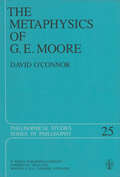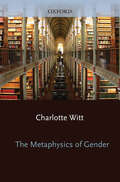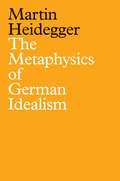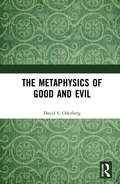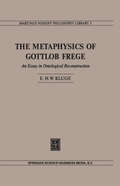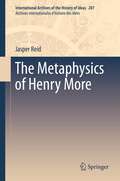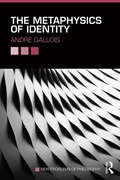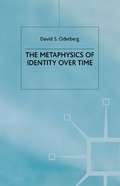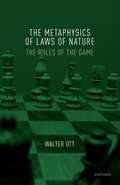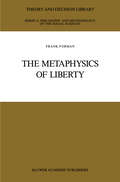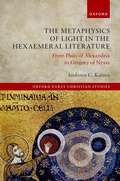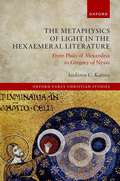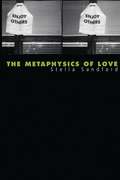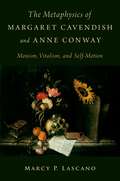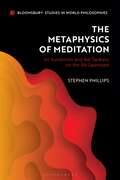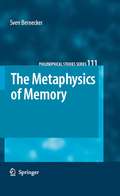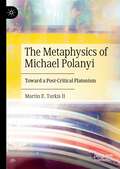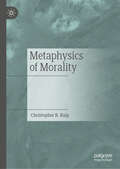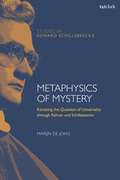- Table View
- List View
The Metaphysics of G. E. Moore (Philosophical Studies Series #25)
by David O'ConnorIn this book, setting aside his consideration of specifically ethical topics, I try to provide a comprehensive interpretation of Moore's thought. Against the background of this general interpretation I examine in detail his work on some of the central problems of metaphysics and, because Moore's being able to sustain a consistent anti-skepticism is essential to the survival of the base from which he works on those problems, of epistemology too. The interpretation of which I speak involves my taking as the centerpiece of Moore's philosophical work his book, Some Main Problems of Philosophy, written in 1910 as the text of a lecture series but left unpublished for over forty years thereafter. That book is aptly titled, for the issues with which Moore deals in it are indeed among the main problems of philosophy. Not least of these are the problems of formulating a general categorial deSCription of the world and then of defending that formulation. However, while I will discuss Moore's work in light of its contribution to this project of taking metaphysical inventory, it is important to note that he, in common with many other major figures in contemporary analytical philosophy, did not approach specific philosophical puzzles with a view to possibly integrating solutions to them into a comprehensive theory about reality as a whole, that is, into what might be called a metaphysical system.
The Metaphysics of Gender
by Charlotte WittThe Metaphysics of Gender is a book about gender essentialism: what it is and why it might be true.
The Metaphysics of German Idealism: A New Interpretation of Schelling's Philosophical Investigations into the Essence of Human Freedom and Matters
by Martin HeideggerThis volume comprises the lecture course that Heidegger gave in 1941 on the metaphysics of German Idealism. The first part of the lecture course contains a preliminary consideration of the distinction between ground and existence. The elucidation of the conceptual history includes a striking confrontation with Kierkegaard’s and Jaspers’ concepts of existence, as well as an elucidation of the concept of existence in Being and Time, which Heidegger distinguishes from the former concepts. Heidegger’s self-interpretation is not an end in itself, however, but rather a way of pointing to Schelling’s distinction between ground and existence, whose root and inner necessity and whose various versions Heidegger discusses subsequently. The second part of the lecture course is focused on Schelling’s “freedom treatise,” which Heidegger regards as the pinnacle of the metaphysics of German Idealism. Heidegger’s consideration of Schelling’s distinction between ground and existence finds its guiding thread in the introduction of the realms of being – eternal or finite, each being is a joining of the ground of existence and existence itself. In a subsequent overview, Heidegger discusses the relation of the distinction between ground and existence to the essence of human freedom and to the essence of the human. On the basis of this discussion, it becomes possible to grasp the connection between freedom and evil in Schelling’s system. This important work by Heidegger, published here in English for the first time, will be of great interest to students and scholars of philosophy and to anyone interested in Heidegger’s work.
The Metaphysics of Good and Evil
by David S. OderbergThe Metaphysics of Good and Evil is the first, full-length contemporary defence, from the perspective of analytic philosophy, of the Scholastic theory of good and evil – the theory of Aristotle, Augustine, Aquinas, and most medieval and Thomistic philosophers. Goodness is analysed as obedience to nature. Evil is analysed as the privation of goodness. Goodness, surprisingly, is found in the non-living world, but in the living world it takes on a special character. The book analyses various kinds of goodness, showing how they fit into the Scholastic theory. The privation theory of evil is given its most comprehensive contemporary defence, including an account of truthmakers for truths of privation and an analysis of how causation by privation should be understood. In the end, all evil is deviance – a departure from the goodness prescribed by a thing’s essential nature. Key Features: Offers a comprehensive defence of a venerable metaphysical theory, conducted using the concepts and methods of analytic philosophy. Revives a much neglected approach to the question of good and evil in their most general nature. Shows how Aristotelian-Thomistic theory has more than historical relevance to a fundamental philosophical issue, but can be applied in a way that is both defensible and yet accessible to the modern philosopher. Provides what, for the Scholastic philosopher, is arguably the only solid metaphysical foundation for a separate treatment of the origins of morality.
The Metaphysics of Good and Evil
by David S. OderbergThe Metaphysics of Good and Evil is the first, full-length contemporary defence, from the perspective of analytic philosophy, of the Scholastic theory of good and evil – the theory of Aristotle, Augustine, Aquinas, and most medieval and Thomistic philosophers. Goodness is analysed as obedience to nature. Evil is analysed as the privation of goodness. Goodness, surprisingly, is found in the non-living world, but in the living world it takes on a special character. The book analyses various kinds of goodness, showing how they fit into the Scholastic theory. The privation theory of evil is given its most comprehensive contemporary defence, including an account of truthmakers for truths of privation and an analysis of how causation by privation should be understood. In the end, all evil is deviance – a departure from the goodness prescribed by a thing’s essential nature. Key Features: Offers a comprehensive defence of a venerable metaphysical theory, conducted using the concepts and methods of analytic philosophy. Revives a much neglected approach to the question of good and evil in their most general nature. Shows how Aristotelian-Thomistic theory has more than historical relevance to a fundamental philosophical issue, but can be applied in a way that is both defensible and yet accessible to the modern philosopher. Provides what, for the Scholastic philosopher, is arguably the only solid metaphysical foundation for a separate treatment of the origins of morality.
The Metaphysics of Gottlob Frege: An Essay in Ontological Reconstruction (Martinus Nijhoff Philosophy Library #5)
by E.H.W KlugeThe Metaphysics of Henry More (International Archives of the History of Ideas Archives internationales d'histoire des idées #207)
by Jasper ReidThe book surveys the key metaphysical contributions of the Cambridge Platonist, Henry More (1614–1687). It deals with such interwoven topics as: the natures of body and spirit, and the question of whether or not there is a sharp ontological division between them; the nature of spatial extension in relation to each; the composition and governance of the physical world, including More’s theories of Hyle, atoms, vacuum, and the Spirit of Nature; and the life of the human soul, including its pre-existence. It approaches these topics and the systematic connections between them both historically and analytically, and seeks to do justice to the ways in which More’s system developed and changed—sometimes quite dramatically—over the course of his long career. It also explores More's intellectual relations with both his own inspirations (Plotinus, Origen, Ficino, Descartes, etc.) and with those who responded, whether positively or negatively, to his work (Leibniz, Locke, Boyle, Newton, etc.).
The Metaphysics of Identity (New Problems of Philosophy)
by André GalloisThe philosophical problem of identity and the related problem of change go back to the ancient Greek philosophers and fascinated later figures including Leibniz, Locke, and Hume. Heraclitus argued that one could not swim in the same river twice because new waters were ever flowing in. When is a river not the same river? If one removes one plank at a time when is a ship no longer a ship? What is the basic nature of identity and persistence? In this book, André Gallois introduces and assesses the philosophical puzzles posed by things persisting through time. Beginning with essential historical background to the problem he explores the following key topics and debates: mereology and identity, including arguments from 'Leibniz's Law' the constitution view of identity the 'relative identity' argument concerning identity temporary identity four-dimensionalism, counterpart and multiple counterpart theory supervenience the problem of temporary intrinsics the necessity of identity Indeterminate identity presentism criteria of identity conventionalism about identity. Including chapter summaries, annotated further reading and a glossary, this book is essential reading for anyone seeking a clear and informative introduction to and assessment of the metaphysics of identity.
The Metaphysics of Identity (New Problems of Philosophy)
by André GalloisThe philosophical problem of identity and the related problem of change go back to the ancient Greek philosophers and fascinated later figures including Leibniz, Locke, and Hume. Heraclitus argued that one could not swim in the same river twice because new waters were ever flowing in. When is a river not the same river? If one removes one plank at a time when is a ship no longer a ship? What is the basic nature of identity and persistence? In this book, André Gallois introduces and assesses the philosophical puzzles posed by things persisting through time. Beginning with essential historical background to the problem he explores the following key topics and debates: mereology and identity, including arguments from 'Leibniz's Law' the constitution view of identity the 'relative identity' argument concerning identity temporary identity four-dimensionalism, counterpart and multiple counterpart theory supervenience the problem of temporary intrinsics the necessity of identity Indeterminate identity presentism criteria of identity conventionalism about identity. Including chapter summaries, annotated further reading and a glossary, this book is essential reading for anyone seeking a clear and informative introduction to and assessment of the metaphysics of identity.
The Metaphysics of Identity over Time
by D. OderbergThis book is a systematic investigation into the metaphysical foundations of identity over time. The author elaborates and evaluates the most common theory about the persistence of objects through time and change, namely the classical theory of spatio-temporal continuity. He shows how the theory requires an ontology of temporal parts, according to which objects are made up of temporally extended segments or stages. This ontology is criticized as unwarranted by modern space-time physics, and as internally incoherent. The author argues that identity over time should be seen as a primitive or unanalysable phenomenon, and that the so-called puzzle cases and paradoxes of identity can be dealt with without recourse to such an ontology.
The Metaphysics of Laws of Nature: The Rules of the Game
by Walter OttIt can seem obvious that we live in a world governed by laws of nature, yet it was not until the seventeenth century that the concept of a law came to the fore. Ever since, it has been attended by controversy: what does it mean to say that Boyle's law governs the expansion of a gas, or that the planets obey the law of gravity? Laws are rules that permit calculations and predictions. What does the universe have to be like, if it is to play by them? This book sorts the most prominent answers into three families. Laws first arose in a theological context; they govern events only because God enforces them. Those wishing to reverse the order of explanation, and argue that the powers of objects fix the laws, struggled to claim for themselves the results of new science. The stand-off between these two families bred a third which rejects any kind of enforcer for the laws. On this view, laws summarize events; they do not govern anything. This book traces the fortunes of the three families, from their origins to the present day. It uses objections - and the revisions needed to answer them - to produce the best representative of each. Along the way, it tries to settle the rules of this game, the debate over laws of nature. What should we expect from an account of laws? The book aims to help readers develop their own desiderata and judge the merits of the competing positions.
The Metaphysics of Laws of Nature: The Rules of the Game
by Walter OttIt can seem obvious that we live in a world governed by laws of nature, yet it was not until the seventeenth century that the concept of a law came to the fore. Ever since, it has been attended by controversy: what does it mean to say that Boyle's law governs the expansion of a gas, or that the planets obey the law of gravity? Laws are rules that permit calculations and predictions. What does the universe have to be like, if it is to play by them? This book sorts the most prominent answers into three families. Laws first arose in a theological context; they govern events only because God enforces them. Those wishing to reverse the order of explanation, and argue that the powers of objects fix the laws, struggled to claim for themselves the results of new science. The stand-off between these two families bred a third which rejects any kind of enforcer for the laws. On this view, laws summarize events; they do not govern anything. This book traces the fortunes of the three families, from their origins to the present day. It uses objections - and the revisions needed to answer them - to produce the best representative of each. Along the way, it tries to settle the rules of this game, the debate over laws of nature. What should we expect from an account of laws? The book aims to help readers develop their own desiderata and judge the merits of the competing positions.
The Metaphysics of Liberty (Theory and Decision Library A: #6)
by Frank FormanPhilosophy suffers from an excess of convoluted introspection. One result is that concepts multiply unchecked. That some events have observable causes gets reified into a First Cause or, in a more secular age, to the thesis that every event is fatalistically determined. Another drawback of convoluted introspection is that tiny but crucial assumptions slip in, often unawares, with the result that densely argued counter-tomes are written in reply and no progress is made toward any kind of consensus. At bottom, subjectivity reigns. I exaggerate. Toward the other pole of the subjectivity-objectivity continuum, consensus among scientists is in fact always at a good healthy distance from compulsive unanimity. New theories replace old, and at any one time the evidence can usually be interpreted two ways. Indeed, it is possible to pile epicycle upon epicycle in the Ptolemaic system of the heavens and approximate the ellipses planets travel in the Copernican system. What cinched the case for Copernicus was not simplicity--after all alchemy is simpler than chemisty. Nor was it experiment--there were no moon shots back then. Rather it was Newton's foundations. He established a physics for the earth and the heavens alike. Earthly physics we can verify, and it does not jell with the Ptolemaic system.
The Metaphysics of Light in the Hexaemeral Literature: From Philo of Alexandria to Gregory of Nyssa (Oxford Early Christian Studies)
by Isidoros C. KatsosThis volume critically re-evaluates the received interpretation of the nature of light in the ancient sources. Isidoros C. Katsos contests the prevalent view in the history of optics according to which pre-modernity theorized light as subordinate to sight ('oculocentrism') by examining in depth the contrary textual evidence found in early Christian texts. It shows that, from Philo of Alexandria and Origen to Basil of Caesarea and Gregory of Nyssa, the Jewish-Christian commentary tradition on the hexaemeral literature (the biblical creation narrative) reflected deeply on the nature and physicality of light for the purposes of understanding the structure and purpose of material creation. Contemplation of nature allowed early Christian thinkers to conceptualize light as the explanatory principle of vision rather than subordinated to it. Contrary to the prevalent view, the hexaemeral literature necessitates a 'luminocentric' interpretation of the theory of light of Plato's Timaeus in its reception history in the context of late antique cosmology. Hexaemeral luminocentrism invites the reader of Scripture to grasp not only the sensible properties of light, but also their causal principle as the first manifestation of the divine Logos in creation. The hexaemeral metaphysics thus provides the missing ground of meaning of the early Christian language of light.
The Metaphysics of Light in the Hexaemeral Literature: From Philo of Alexandria to Gregory of Nyssa (Oxford Early Christian Studies)
by Isidoros C. KatsosThis volume critically re-evaluates the received interpretation of the nature of light in the ancient sources. Isidoros C. Katsos contests the prevalent view in the history of optics according to which pre-modernity theorized light as subordinate to sight ('oculocentrism') by examining in depth the contrary textual evidence found in early Christian texts. It shows that, from Philo of Alexandria and Origen to Basil of Caesarea and Gregory of Nyssa, the Jewish-Christian commentary tradition on the hexaemeral literature (the biblical creation narrative) reflected deeply on the nature and physicality of light for the purposes of understanding the structure and purpose of material creation. Contemplation of nature allowed early Christian thinkers to conceptualize light as the explanatory principle of vision rather than subordinated to it. Contrary to the prevalent view, the hexaemeral literature necessitates a 'luminocentric' interpretation of the theory of light of Plato's Timaeus in its reception history in the context of late antique cosmology. Hexaemeral luminocentrism invites the reader of Scripture to grasp not only the sensible properties of light, but also their causal principle as the first manifestation of the divine Logos in creation. The hexaemeral metaphysics thus provides the missing ground of meaning of the early Christian language of light.
The Metaphysics of Love: Gender and Transcendence in Levinas
by Stella SandfordEmmanuel Levinas is best known for having reintroduced the question of ethics into the Continental philosophical tradition. In The Metaphysics of Love, however, Stella Sandford argues that an over-emphasis on ethics in the reception of Levinas's thought has covered over both the basis and the details of his philosophical project--a metaphysics which affirms the necessity to think of an unqualified transcendence as a first principle. Sandford's book is at the same time a powerful feminist critique of both Levinas's gendered philosophical categories and the attempt to reclaim aspects of this philosophy for feminist theory.
The Metaphysics of Love: Gender and Transcendence in Levinas
by Stella SandfordEmmanuel Levinas is best known for having reintroduced the question of ethics into the Continental philosophical tradition. In The Metaphysics of Love, however, Stella Sandford argues that an over-emphasis on ethics in the reception of Levinas's thought has covered over both the basis and the details of his philosophical project--a metaphysics which affirms the necessity to think of an unqualified transcendence as a first principle. Sandford's book is at the same time a powerful feminist critique of both Levinas's gendered philosophical categories and the attempt to reclaim aspects of this philosophy for feminist theory.
The Metaphysics of Margaret Cavendish and Anne Conway: Monism, Vitalism, and Self-Motion
by Marcy P. LascanoMarcy P. Lascano examines the philosophical systems of Margaret Cavendish and Anne Conway. Cavendish and Conway are both known for their monism, i.e., the view that there is only one kind of substance in the world, which is capable of self-motion and life. Lascano here provides detailed analyses of their respective accounts of monism, substance, self-motion, individuation, and identity over time, as well as causation, perception, and freedom. She thereby shows how their superficially similar views provide importantly different explanations of the workings of the world. Lascano illuminates under-appreciated nuances in Cavendish's and Conway's views, highlighting the important differences between their systems. Examining their views in tandem allows readers to appreciate the originality of their ideas and their responses to seventeenth-century debates. The book's final chapter then explains how Cavendish's metaphysics lays the groundwork for her natural philosophy, while Conway's metaphysics provides the foundation for her theodicy. Drawing on their original writing and engaging with existing scholarship, Lascano presents the first sustained comparison of Cavendish's and Conway's metaphysics revealing the differences between Cavendish's thoroughgoing naturalism and Conway's spiritualism. In turn, she enlarges our view of these thinkers and their unique ways of understanding the world around us.
The Metaphysics of Margaret Cavendish and Anne Conway: Monism, Vitalism, and Self-Motion
by Marcy P. LascanoMarcy P. Lascano examines the philosophical systems of Margaret Cavendish and Anne Conway. Cavendish and Conway are both known for their monism, i.e., the view that there is only one kind of substance in the world, which is capable of self-motion and life. Lascano here provides detailed analyses of their respective accounts of monism, substance, self-motion, individuation, and identity over time, as well as causation, perception, and freedom. She thereby shows how their superficially similar views provide importantly different explanations of the workings of the world. Lascano illuminates under-appreciated nuances in Cavendish's and Conway's views, highlighting the important differences between their systems. Examining their views in tandem allows readers to appreciate the originality of their ideas and their responses to seventeenth-century debates. The book's final chapter then explains how Cavendish's metaphysics lays the groundwork for her natural philosophy, while Conway's metaphysics provides the foundation for her theodicy. Drawing on their original writing and engaging with existing scholarship, Lascano presents the first sustained comparison of Cavendish's and Conway's metaphysics revealing the differences between Cavendish's thoroughgoing naturalism and Conway's spiritualism. In turn, she enlarges our view of these thinkers and their unique ways of understanding the world around us.
The Metaphysics of Meditation: Sri Aurobindo and Adi-Sakara on the Isa Upanisad (Bloomsbury Studies in World Philosophies)
by Stephen PhillipsIn this book Stephen Phillips focuses on one of the most important poems about meditation in world literature, as understood by two of the greatest philosophers of India, one classical, one modern. Sankara's commentaries on the Upanisads are a core of the Vedanta tradition and Aurobindo is a towering figure of 20th-century Hindu thought. This is the first time their approaches have been studied together.The Isa (c. 500 BCE) an “Upanisad” belongs to a genre of “adhyatmika” learning-concerning self and consciousness-in early Indian literature. According to the Ancient Indian tradition of yoga, meditation is antithetical to willful bodily and mental action. Breathing is all you do. In the conception of the Isa Upanisad, we are told that the best that comes from meditation is because of what the “Lord” is. In Sankara's interpretation it comes to block out the little “you,” whereas according to Aurobindo it comes as a divine connection, an occult “Conscious Force” belonging to truer part of oneself, atman, and an “opening” to that self's native energy. Framed around Aurobindo's translation of each of the Isa's eighteen verses, along with a translation of each verse, Phillips follows a different reading of Sankara as laid out in his commentary. All this is done against the backdrop of modern scholarship. Convergences and divergences of these streams are the focus throughout. Appendix A presents the Upanisad with the two readings side by side.This book traces a worldview and consonant yoga teaching common to two authors who are typically taken to be oceans apart, not only chronologically but in intellectual stance. Addressing a huge gap in the contemporary literature on meditation in the Hindu traditions, Phillips presents a compelling new way of thinking about meditation in the Advaita Vedanta philosophy and Upanisad.
The Metaphysics of Meditation: Sri Aurobindo and Adi-Sakara on the Isa Upanisad (Bloomsbury Studies in World Philosophies)
by Stephen PhillipsIn this book Stephen Phillips focuses on one of the most important poems about meditation in world literature, as understood by two of the greatest philosophers of India, one classical, one modern. Sankara's commentaries on the Upanisads are a core of the Vedanta tradition and Aurobindo is a towering figure of 20th-century Hindu thought. This is the first time their approaches have been studied together.The Isa (c. 500 BCE) an “Upanisad” belongs to a genre of “adhyatmika” learning-concerning self and consciousness-in early Indian literature. According to the Ancient Indian tradition of yoga, meditation is antithetical to willful bodily and mental action. Breathing is all you do. In the conception of the Isa Upanisad, we are told that the best that comes from meditation is because of what the “Lord” is. In Sankara's interpretation it comes to block out the little “you,” whereas according to Aurobindo it comes as a divine connection, an occult “Conscious Force” belonging to truer part of oneself, atman, and an “opening” to that self's native energy. Framed around Aurobindo's translation of each of the Isa's eighteen verses, along with a translation of each verse, Phillips follows a different reading of Sankara as laid out in his commentary. All this is done against the backdrop of modern scholarship. Convergences and divergences of these streams are the focus throughout. Appendix A presents the Upanisad with the two readings side by side.This book traces a worldview and consonant yoga teaching common to two authors who are typically taken to be oceans apart, not only chronologically but in intellectual stance. Addressing a huge gap in the contemporary literature on meditation in the Hindu traditions, Phillips presents a compelling new way of thinking about meditation in the Advaita Vedanta philosophy and Upanisad.
The Metaphysics of Memory (Philosophical Studies Series #111)
by Sven BerneckerThis book investigates central issues in the philosophy of memory. Does remembering require a causal process connecting the past representation to its subsequent recall and, if so, what is the nature of the causal process? Of what kind are the primary intentional objects of memory states? How do we know that our memory experiences portray things the way they happened in the past? Given that our memory is not only a passive device for reproducing thoughts but also an active device for processing stored thoughts, when are thoughts sufficiently similar to be memory-related? The Metaphysics of Memory defends a version of the causal theory of memory, argues for direct realism about memory, proposes an externalist response to skepticism about memory knowledge, and develops a contextualist account of the factivity constraint on memory.
The Metaphysics of Michael Polanyi: Toward a Post-Critical Platonism
by Martin E. Turkis IIThis book tells the story of how the Platonic vision of Michael Polanyi – the Hungarian-British chemist and philosopher – bridges the gap between speculative metaphysics and scientific practice, thus making sense of the broad swathe of human experience in a phenomenologically satisfying fashion. The central proposal is that Polanyi is a Platonist due to his affirmation of the ontological status of abstract objects, with particular focus placed on the question of uninstantiated universals. The book engages contemporary, speculative realists from both continental and analytic traditions as it introduces Polanyi’s influential epistemology and unpacks the fascinating metaphysics implied thereby. It then proceeds to develop Polanyi’s rather unsystematic metaphysics into a coherent, post-critical Platonism which incorporates his well-known theory of tacit knowledge, thus achieving something akin to the ancient Neoplatonic synthesis of Plato and Aristotle in our contemporary, scientific context.
Metaphysics of Morality
by Christopher B. KulpThis is a book on metaethics—in particular, an inquiry into the metaphysical foundations of morality. After carefully exploring the metaphysical commitments, or lack thereof, of the leading versions of moral anti-realism, Kulp develops a new and in-depth theory of moral realism. Starting with the firm recognition of the importance of our common sense belief that we possess a great deal of moral knowledge—that, for example, some acts are objectively right and some objectively wrong—the book goes on to examine the metaphysical grounds of various skeptical responses to this perspective. In great part, the book is devoted to developing a version of realist metaethics: specifically, developing in detail realist theories of moral truth, moral facts, and moral properties.Concluding with the rejection of prominent contemporary forms of moral anti-realism, Kulp presents a rigorous non-naturalistic theory of moral realism, and a vindication of the basic commitments of commonsense moral thought.
Metaphysics of Mystery: Revisiting the Question of Universality through Rahner and Schillebeeckx (T&T Clark Studies in Edward Schillebeeckx)
by Marijn de JongHow can we theologically reflect on universality in a world that increasingly focuses on particularities and differences? Marijn de Jong argues that the question of universality calls for a reconceptualised form of metaphysical theology, which he finds in the work of Karl Rahner and Edward Schillebeeckx. Casting a new light on these theologians, De Jong demonstrates that their methods contain a dialectical interrelation of hermeneutics and metaphysics. An interrelation which seemingly has been lost in more recent hermeneutical theology, Rahner and Schillebeeckx carefully balance particularity and universality without falling prey to relativist or absolutist ways of reasoning. By analyzing fundamental themes such as experience and interpretation, nature and grace, faith and reason, and intelligibility and mystery, De Jong reveals the modest theological metaphysics that lies at the heart of their methods. This critical retrieval demonstrates the enduring relevance of these thinkers and opens up new avenues of thought for theologians that do not want to shy away from the difficult question of the universality of God.
